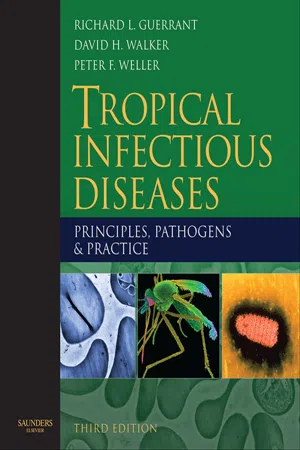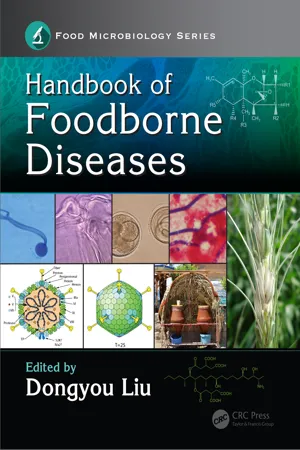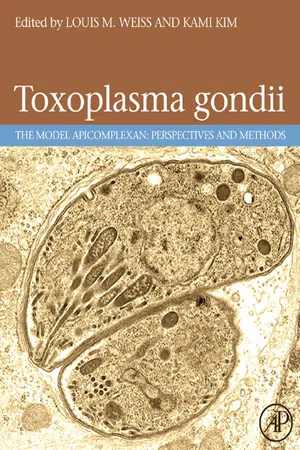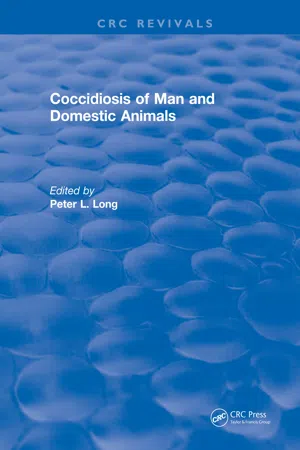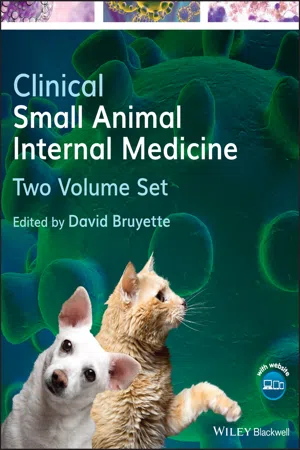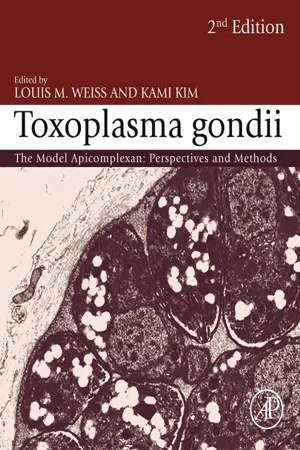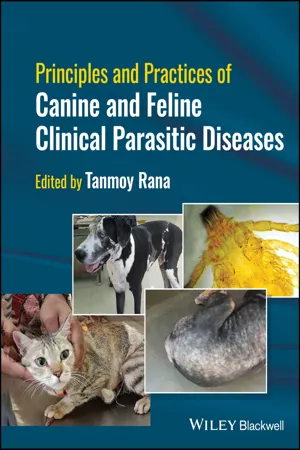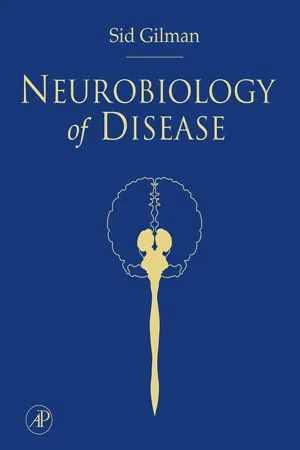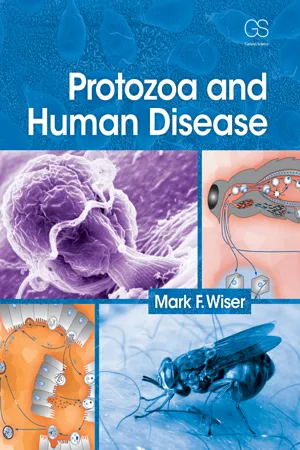Biological Sciences
Toxoplasmosis
Toxoplasmosis is a parasitic infection caused by the Toxoplasma gondii parasite. It can be transmitted through the ingestion of contaminated food or water, or through contact with infected cat feces. While most healthy individuals may not experience severe symptoms, it can pose serious risks to pregnant women and individuals with weakened immune systems.
Written by Perlego with AI-assistance
Related key terms
Related key terms
1 of 4
Related key terms
1 of 3
11 Key excerpts on "Toxoplasmosis"
- eBook - ePub
- Sunit Kumar Singh, Sunit Kumar Singh(Authors)
- 2015(Publication Date)
- Wiley-Blackwell(Publisher)
Chapter 16Pathogenesis of Toxoplasma gondii in HumansHong-Juan Peng1 , Feng Tan2 , and David S. Lindsay31 Department of Pathogen Biology, School of Public Health and Tropical Medicine, Southern Medical University, Guangdong Province, P.R. China2 Department of Parasitology, Wenzhou Medical University, Zhejiang Province, P.R. China3 Center for Molecular Medicine and Infectious Diseases, Department of Biological Sciences and Pathobiology, Virginia-Maryland Regional College of Veterinary Medicine, Virginia Tech, Blacksburg, VA, USA16.1 Pathogen epidemiology
Toxoplasma gondii is an intracellular protozoan in the Phylum Apicomplexa, Class Sporozoasida, Subclass Coccidiasina, Order Eucoccidiorida, Suborder Eimeriorina, and Family Sarcocystidae. There is only one species. It can infect and develop in almost all nucleated cells. The disease caused by the parasite is a zoonosis called Toxoplasmosis. It can manifest itself as many clinical presentations including: (i) congenital Toxoplasmosis (CT), causing mental retardation, hearing, and ocular problems in infected fetuses (Torgerson and Mastroiacovo, 2013), (ii) ocular Toxoplasmosis (Bodaghi et al., 2012), (iii) transplantation-acquired infections, causing life-threatening infections in organ recipients (Derouin and Pelloux, 2008), (iv) reactivated encephalitis (toxoplasmic encephalitis) in highly immunosuppressed patients (Yan et al., 2013), and (v) non-specific, flu-like illness in immunocompetent individuals (Weiss and Dubey, 2009). Less well documented, is the association of chronic T. gondii infection with mental illness and behavioral alteration in patients (Webster et al., 2013).The prevalence rates of T. gondii infection among healthy people range from 7.5% to 80% worldwide. Prevalence is estimated to be 10–40% in the United States and the United Kingdom, 50–80% in Central and South America, and continental Europe, and about 7.5% among the Chinese population (Xiao et al., 2010). It is estimated that about one-third of the world's population is latently infected with T. gondii. The definitive hosts for T. gondii - Richard L. Guerrant, David H. Walker, Peter F. Weller(Authors)
- 2011(Publication Date)
- Saunders(Publisher)
CHAPTER 103 ToxoplasmosisJoseph D. Schwartzman, James H. MaguireIntroduction
Access the complete reference list online at http://www.expertconsult.comToxoplasma gondii is a versatile intracellular parasite that has adapted to infect many animal species and is capable of causing a wide spectrum of disease, the preponderance of which is asymptomatic. Invasion of host cells leads to their eventual death; a complex interplay of host cell-mediated immune responses arrests acute infection and maintains continued suppression of the persistent encysted zoites, usually for the life of the host. The wide host range of T. gondii is an exception in contrast to other members of the phylum Apicomplexa. Toxoplasma also has a wide geographic range: its single species is found worldwide. The ability to infect many species by at least two routes and its broad distribution are responsible for the high prevalence of infections in humans; perhaps a third of the world’s people are chronically infected by T. gondii . Serious illness is unusual except among persons with deficient cell-mediated immunity and infants infected in utero . Toxoplasmosis is an important cause of abortion in sheep, swine, and goats.1, 2The Agent
History and Taxonomy
In 1908, Nicolle and Manceaux3 identified T. gondii in a laboratory rodent, the North African gondi; and Splendore4 noted identical forms in a laboratory rabbit. Recognition of the importance of this parasite for humans came in 1937 when it was identified as a cause of “granulomatous encephalomyelitis.”5 The role of chronic infection was appreciated in the 1950s by demonstrating Toxoplasma in eyes previously thought to have been involved with tuberculosis or syphilis.6 The high prevalence of Toxoplasmosis was only realized after the serologic dye test was developed by Sabin and Feldman in 1948.7 Congenital Toxoplasmosis in infants was recognized before either generalized disease in adults or the lymphadenitis of primary Toxoplasma infections in adults was appreciated.5 Roles of reactivated latent infections in producing disease in immunosuppressed adults were recognized at the outset of solid organ transplantation.8 The onset of acquired immunodeficiency syndrome (AIDS) brought recognition of central nervous system (CNS) reactivation causing multifocal encephalitis.9- eBook - ePub
- Dongyou Liu, Dongyou Liu(Authors)
- 2018(Publication Date)
- CRC Press(Publisher)
59 Toxoplasma Fernanda Silva de Souza and Renato Augusto DaMattaContents 59.1Introduction 59.2Classification and Morphology 59.3Life Cycle 59.4Epidemiology 59.5Clinical Features 59.6Pathogenesis 59.7Diagnosis 59.8Treatment 59.9Prevention 59.10Conclusion and Future Perspectives Acknowledgments References59.1IntroductionWith more than 200 diseases known to be transmitted through food and drink, establishing the association of illnesses with a specific pathogen or food source is complex and difficult, and finding effective means to control and prevent such illnesses is even more challenging.1 – 4Among pathogenic organisms that contaminate foods and drinks, Toxoplasma gondii 1 , 5 , 6 is a protozoan first discovered in 1908, independently, by Splendore7 and Nicolle and Manceaux.8 The name of the genus came from the arched form of the parasite and the name of the species from the rodent in which the parasite was isolated in Africa, Ctenodactylus gundi .8 , 9 Despite its initial description in 1908, its role in human infection was proven only in 1939 through the autopsy of an infant with clinical features of encephalomyelitis and chorioretinitis.10T. gondii is an obligated intracellular protozoan parasite11 with a complex life cycle involving sexual and asexual phases. The organism can be found practically all over the world and is capable of infecting all warm-blooded animals.12 , 13 This parasite shows three infectious stages: (1) tachyzoite, capable of fast division in host cells; (2) bradyzoite, established in tissue cysts with slow division; and (3) sporozoite, found inside sporulated oocysts that are shed in the environment by the definitive host,14 which belongs to the Felidae family.15Toxoplasmosis is one of the most common infections in humans. There are three main routes of transmission: congenital infection (mother-fetus), ingestion of food infected with tissue cysts or oocysts, and drink contaminated with oocysts.1 , 5 , 6 Once infected, the host will have the parasite for life. In immunocompetent individuals, the infection is normally asymptomatic. The most serious cases occur in congenital infection and immunocompromised individuals.13 , 16 Congenital infection in humans was hypothesized by Wolf et al.10 and proven in 1959 by Beverley17 through observation of transmission among generations of infected mice. Congenital infection normally occurs in humans when a woman is infected with T. gondii during pregnancy, and this can lead to many manifestations in the fetus, including abortion.18 - eBook - ePub
Toxoplasma Gondii
The Model Apicomplexan. Perspectives and Methods
- Louis M. Weiss, Kami Kim(Authors)
- 2011(Publication Date)
- Academic Press(Publisher)
1The History and Life Cycle of Toxoplasma gondii
J.P. DubeyPublisher Summary
Infections by the protozoan parasite Toxoplasma gondii are widely prevalent in humans and other animals on all continents. This chapter provides a history of the milestones in the acquisition of knowledge of the biology of this parasite. Toxoplasmosis in sheep deserves special attention because of its economic impact. The identification of T. gondii abortion in ewes is considered a landmark discovery in veterinary medicine; prior to that, protozoa were not recognized as a cause of epidemic abortion in livestock. The ability to identify T. gondii infections based on a simple serological test opened the door for extensive epidemiological studies on the incidence of infection. It became clear that T. gondii infections are widely prevalent in humans in many countries. It also demonstrated that the so-called tetrad of clinical signs considered indicative of clinical congenital Toxoplasmosis occurred in other diseases and assisted in the differential diagnosis. Vaccination of sheep with a live cystless strain of T. gondii reduces neonatal mortality in lambs, and the vaccine is available commercially.1.1. Introduction1.2. The etiological agent1.3. Parasite morphology and life cycle1.4. Transmission1.5. Toxoplasmosis in humans1.6. Toxoplasmosis in other animals1.7. Diagnosis1.8. Treatment1.9. Prevention and controlAcknowledgements References1.1 INTRODUCTION
Infections by the protozoan parasite Toxoplasma gondii - eBook - ePub
- Peter L. Long(Author)
- 2019(Publication Date)
- CRC Press(Publisher)
Chapter 7TOXOPLASMA: BIOLOGY, PATHOLOGY, IMMUNOLOGY, AND TREATMENT Alan M. Johnson TABLE OF CONTENTS I Introduction II Life Cycle III Antigenic Structure A Surface Antigens B Excretory/Secretory Antigens C Intracellular Antigens D Nucleoside Triphosphate Hydrolase E Stage-Specific and Strain-Specific Antigens F Other Potentially Diagnostic Antigens IV Molecular Biology A Nucleic Acid Characterization B Phylogeny/Taxonomy Studies C Nucleic Acid Detection V Immunology A Lymphocyte Transformation B Relevance of Natural Killer Cells C Oxygen-Dependent vs. Oxygen-Independent Parasite Killing VI Pathology A Humans 1 Immunocompetent a Lymphadenopathy b Congenital 2 Immunoincompetent B Animals VII Vaccines VIII Treatment IX Conclusion/Future Trends ReferencesI Introduction
Toxoplasma gondii is a ubiquitous protistan parasite of animals. Work on this parasite, and Toxoplasmosis, the disease it causes, has been the subject of thousands of publications. A two-volume bibliography published in 19831 contained 12,476 references. Therefore, the number of publications on the biology, pathology, and immunology of T. gondii published at the time of writing this chapter must be in the tens of thousands. It is impossible to distill all available information into this chapter, accordingly this chapter concentrates on work in the major areas of interest of T. gondii research published during the last 5 years and thus remains an enormous task. Research carried out prior to 1982 on pathology and immunology was well covered earlier.2Other older reference works and several recent books, book chapters, and reviews on specific areas of T. gondii research will be referenced where appropriate. In addition, some of the material published well before 1982 will be covered here in order to place the work discussed in this chapter in perspective. Earlier work is used as a basis from which to suggest the directions in which future research on T. gondii - eBook - ePub
- David Bruyette, David Bruyette(Authors)
- 2020(Publication Date)
- Wiley-Blackwell(Publisher)
110 Protozoal and Protozoa‐Like Infections Gad Baneth, DVM, PhD, DECVCP1 and Laia Solano‐Gallego, DVM, PhD, DECVCP2 1 School of Veterinary Medicine, Hebrew University, Rehovot, Israel 2 Facultat de Veterinaria, Universitat Autonoma de Barcelona, Barcelona, SpainParasites are responsible for some of the most important and widespread diseases of domestic dogs and cats. Some of these parasitic infections are also zoonotic and can infect humans. A thorough understanding of the pathogenesis and epidemiology of these parasitic diseases is required in order to treat infected pets and prevent the spread of disease efficiently. This chapter focuses on important protozoal diseases in dogs and cats with emphasis on etiology, pathophysiology, clinical manifestations, diagnosis, treatment, and prevention.Toxoplasmosis
Etiology and Pathophysiology
Toxoplasma gondii is a tissue coccidian protozoon with a sexual life cycle in the intestine of felids, the definitive host, and an asexual phase in intermediate hosts. The intermediate hosts of T. gondii include all warm‐blooded vertebrates including humans. Cats and intermediate hosts can be infected by bradyzoites in meat or by sporulated T. gondii oocysts from cat feces. Cats shed T. gondii oocysts in their feces within 3–10 days after infection by bradyzoites from tissue cysts and excretion continues for approximately 7–21 days (median eight days) with massive shedding which can reach hundreds of millions of oocysts per cat during the shedding period. After that initial period, risk of further oocyst shedding is limited. Oocysts in cat feces undergo sporulation in the environment and develop sporocysts containing infective sporozoites within 1–5 days in appropriate humidity, temperature, and oxygenation conditions [1 ].After oral infection, T. gondii - eBook - ePub
Toxoplasma Gondii
The Model Apicomplexan - Perspectives and Methods
- Louis M. Weiss(Author)
- 2013(Publication Date)
- Academic Press(Publisher)
Chapter 1The History and Life Cycle of Toxoplasma gondii
Jitender P. Dubey, Animal Parasitic Diseases Laboratory, Beltsville Agricultural Research Center, Agricultural Research Service, United States Department of Agriculture, Beltsville, Maryland, USAAbstract
Toxoplasma gondii has a complex life cycle with multiple forms. Intermediate hosts such as humans are infected by sporozoites in oocysts or bradyzoites in pseudocysts whereas the sexual stages occur in the intestine of the definitive host, feline species. The parasite is unusual in that it does not need to pass through sexual stages or its definitive host for transmission to other species. This chapter summarizes the history of the discovery of the parasite, identification of the definitive host and transmission stages of the parasite, as well as other important discoveries in the basic biology and life cycle of T. gondii . This chapter also provides photomicrographs of the life cycle stages of this organism.OutlineKeywords
tachyzoite; bradyzoite; sporozoite; sexual cycle; transmission; Toxoplasmosis; diagnosis1.1 Introduction 1.2 The Etiological Agent 1.3 Parasite Morphology and Life Cycle 1.3.1 Tachyzoites 1.3.2 Bradyzoite and Tissue Cysts 1.3.3 Enteroepithelial Asexual and Sexual Stages 1.4 Transmission 1.4.1 Congenital 1.4.2 Carnivorism 1.4.3 Faecal–Oral 1.5 Toxoplasmosis in Humans 1.5.1 Congenital Toxoplasmosis 1.5.2 Acquired Toxoplasmosis 1.5.2.1 Children 1.5.2.2 Toxoplasmosis in Adults 1.6 Toxoplasmosis in Other Animals 1.7 Diagnosis 1.7.1 Sabin–Feldman Dye Test 1.7.2 Detection of IgM Antibodies 1.7.3 Direct Agglutination Test1.7.4 Detection of T. gondii DNA1.8 Treatment 1.9 Prevention and Control 1.9.1 Serologic Screening During Pregnancy 1.9.2 Hygiene Measures 1.9.3 Animal Production Practices 1.9.4 Vaccination Acknowledgements ReferencesAcknowledgements
I would like to thank Drs. Georges Desmonts (now deceased), David Ferguson, Jack Frenkel, H.R. Gamble, Garry Holland, Jeff Jones, and Jack Remington for their helpful discussions in the preparation of this manuscript. - Tanmoy Rana(Author)
- 2024(Publication Date)
- Wiley-Blackwell(Publisher)
15 Parasitic Zoonoses and One HealthHanumappa DhanalakshmiDepartment of Veterinary Parasitology, Veterinary College, Hebbal, Bengaluru, IndiaParasitic zoonoses refer to the infections caused by protozoa, helminths, and arthropods that are transmitted from animals to humans. The variety of animal hosts and mode of transmission vary greatly.During the nineteenth and twentieth centuries, the concept of One Health was initiated by Rudolf Virchow (called the father of comparative medicine, cellular pathology, and veterinary pathology) and William Osler (called the father of modern medicine). According to the World Health Organization (WHO), One Health is an integrated, unifying approach to balance and optimize the health of people, animals, and environment. The One Health approach encourages interdisciplinary and trans‐disciplinary collaborations and communication between scientists and policy makers. In this chapter, zoonotic parasites and their control from a One Health perspective are discussed.15.1 Zoonoses Caused by Protozoa
15.1.1 Toxoplasmosis
Toxoplasmosis is a significant protozoan disease that occurs in humans and animals worldwide. It is of particular importance in pregnant women and immunocompromised individuals. It has been estimated that up to one‐third of the world's human population is exposed to Toxoplasmosis.15.1.1.1 Etiology
In the year 1908, Nicolle and Manceaux found a protozoan in the tissues of a hamster‐like rodent, the gundi, Ctenodactylus gundi, and named it Toxoplasma gondii based on its morphology (“toxo” means arc or bow, “plasma” means life). T. gondii is the only etiological agent present in the genus. It is an intracellular parasite for which cats and wild felids act as definitive hosts. However, it is capable of infecting almost all warm‐blooded animals, including humans.15.1.1.2 Transmission
Transmission to humans occurs by oral ingestion of sporulated oocyts or the consumption of raw meat infected with cysts. Epidemiological evidence indicates that it is common in humans in some locals where raw meat is routinely eaten [1]- eBook - ePub
- (Author)
- 2011(Publication Date)
- Academic Press(Publisher)
19 ].D. Toxoplasmosis
1. Brief History
Toxoplasmosis is caused by the widely distributed obligate intracellular protozoan parasite Toxoplasma gondii. Over 500 million of the world’s population have serum antibodies to T. gondii, although most infected adults are asymptomatic. Reactivation of latent disease in immunocompromised patients results in disseminated Toxoplasmosis and toxoplasmic encephalitis. These conditions are still rare but are increasing in incidence with the rise of the HIV/AIDS pandemic [20 ].Congenital Toxoplasmosis is found more commonly and has a birth prevalence from 1–10% to per 10,000 live births. Maternal infection in the first or second trimester may lead to severe congenital Toxoplasmosis and intrauterine death, whereas late maternal infections usually result in normal appearing newborns. About 85% of newborns with congenital Toxoplasmosis have subclinical infection [20 ].2. Etiology
T. gondii is a remarkably clonal species and only three clonal lineages have been identified that differ in virulence and epidemiology. Types I and II have been recorded in congenital disease, type II in patients with AIDS, and type III in strains isolated from animals [20 ]. Factors including inoculum size, virulence of the organism, genetic background of the host, sex, and immunological status affect the course of infection in humans and animal models [20 ].The definitive hosts of T. gondii are members of the cat family. Sexual replication of the parasite occurs in the intestine, resulting in the production of large numbers of oocysts in the feces. Sporulation takes 7–21 days, after which the oocysts become infective when ingested by mammals and develop into tachyzoites. The tachyzoite is the rapidly multiplying asexual form of the parasite and is able to invade all nucleated cells. Replication leads to death of the host cell, as well as neighboring cells, and incites a strong inflammatory response. This immune response stimulates the production of cysts containing bradyzoites, which then are undetectable by the immune system. The bradyzoites slowly multiply within the cysts and can be re-released and transform into tachyzoites, causing recrudescence of infection. Cysts can form in brain, skeletal, and heart muscle and are infective if consumed [20 - eBook - ePub
- Mark F Wiser(Author)
- 2010(Publication Date)
- Garland Science(Publisher)
Toxoplasma based on serological evidence. The prevalence varies with location with the United States and the United Kingdom exhibiting prevalences ranging from 16 to 40%, whereas prevalences in continental Europe and Central and South America range from 50 to 80%. Despite the high incidence of infection, Toxoplasmosis is often unrecognized because it most often causes a benign disease with few or no symptoms. Noted exceptions are in the cases of congenital infection or immunocompromised individuals.Life Cycle and Transmission
Toxoplasma has a complex life cycle consisting of intestinal and tissue phases (Figure 14.1 ). Although the organism was first discovered in 1908 as a tissue parasite of the gundi, its complete life cycle was not determined until 1970. The life cycle is described as being predator–prey transmission in that the predator acquires the infection by eating a prey infected with the tissue stage of the parasite. Within the prey host the parasite undergoes an intestinal phase resulting in the excretion of the form infective for the predator. The intestinal phase of Toxoplasma only occurs in felids and is nearly identical to that of Isospora (Chapter 13 ). Cats acquire the infection by eating animals infected with the tissue stage of the parasite. This stage is often referred to as the tissue cyst and contains hundreds to thousands of bradyzoites. The bradyzoites invade intestinal epithelial cells and undergo an asexual replication called merogony that ends in the production of merozoites. The resulting merozoites are released from the infected cell and invade other intestinal epithelial cells and can then either undergo additional rounds of merogony or undergo gametogony. Similarly to other apicomplexa (Chapter 11 ), gametogony results in the production of macro and microgametes. Thus, the cat is considered the definitive host - eBook - ePub
- Felipe Kierzenbaum(Author)
- 2013(Publication Date)
- Academic Press(Publisher)
Van de Ven, 1992 ). In contrast, sheep congenital Toxoplasmosis, which is of considerable economic importance, cannot be considered as a relevant experimental model since the ovine placenta is structurally very different from human, rodent, and primate placentas.The mechanisms by which T. gondii acute infection affects the host immune system are not yet fully understood. In human acute Toxoplasmosis, the T-cell dysfunction is characterized by impaired T-cell proliferation as well as IFN-γ and IL-2 production in response to stimulation with T. gondii or parasite-unrelated antigens, but not with mitogens. Abnormalities in cell populations, mostly an increase in the CD8+ T-cell subset, as well as T-cell dysfunction are more pronounced in symptomatic patients than in asymptomatic ones. The mechanisms responsible for the increased in vivo selection of CD8+ T cells remain to be disclosed. Further studies are also needed to determine whether the CD8+ T cells act as suppressor cells (responsible for pathology) or as cytotoxic cells which could play a role in further healing. In mice, the immunological disorders that accompany T. gondii acute infection differ to some extent from those observed in humans. If CD8+ T-cell subsets are also increased, the more striking increase affects spleen and lymph node macrophages. T-cell functions such as proliferation and IFN-γ production are markedly depressed, in response not only to T. gondii antigens but also to mitogens. Moreover, a marked decrease in antibody production to both T -dependent and T -independent antigens is observed. This suppressive effect on T and B memory cells is mediated by suppressive plastic-adherent cells, and not by CD8+ T cells. The mechanisms implicated in the in vivo induction of these “suppressor” macrophages and in their action on the lymphocyte stimulation involved in primary antibody responses deserve further study. Here again, and because of differences in immunologic dysfunction developing in humans and mice with acute T. gondii
Index pages curate the most relevant extracts from our library of academic textbooks. They’ve been created using an in-house natural language model (NLM), each adding context and meaning to key research topics.
Explore more topic indexes
Explore more topic indexes
1 of 6
Explore more topic indexes
1 of 4

